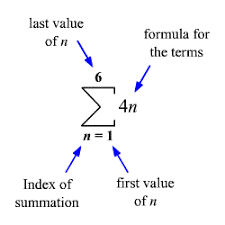Series
Table of contents |
|
|
Meaning of Series
Series is the sum of all the numbers of the sequence. Generally it is written as Sn.
Example
If we have a sequence 1, 2, 3, 4, …
Then the series of this sequence is 1 + 2 + 3 + 4 +…
History of Series
The first known summation of an infinite series was produced by Greek mathematician Archimedes which is still used in the area of calculus today.
Mathematicians from Kerala, India studied infinite series in around 1350 CE.
Notation of Series
We use the sigma notation that is, the Greek symbol “Σ” for the series which means “sum up”.
The series 4+8+12+16+20+24 can be expressed as ∑6n = 1 = 4n. We read this expression as the sum of 4n as n goes from 1 to 6.
This is the compact form of the series so we can generate the terms of the series by the formula easily.
To generate the terms of the series given in sigma notation above we have to replace the n with 1, 2,3,4,5 and 6 as the last number of term is 6.

Difference between Sequence and Series
|
Sequence |
Series |
|
It is the value which we get by adding up the terms of the sequences. |
|
|
Its notation is
|
Its notation is
|
|
Example 2, 4, 6, 8,… |
Example |
Finite and Infinite Series
A series which have a limited number of terms is called Finite Series.
2 + 4 + 6 + 8 + 10
A series which have unlimited number of terms is called Infinite Series.
Convergent and Divergent Series
If we have a sum of a series which is approaching towards a finite value is called a Convergent Series. And if a sum does not converge then it is called divergent series.
A series ∑an is said to converge or to be convergent when the sequence (sk) of partial sums has a finite limit. If the limit of sk is infinite or does not exist, the series is said to diverge.
Example
Find whether the series is convergent or divergent.
Here the sum of the series would be

But if this is not true then it would be a divergent series.
Comparison test
This is the test to check whether a series is convergent or divergent.
Let us take two series

where, an, bn ≥ 0
and an ≤ bn for all n =1, 2, 3 …
This tells us that these series are either diverges to positive infinity or they are going to converge to finite value.
that is, if the larger series converges then the smaller series also converges.

that is, if the smaller series diverges then the larger series also diverges.
Properties of Series
The series are not only differentiated by their convergence or divergence but also by the properties of the term an .
Non Negative term
When an is a non-negative real number for every n, the sequence SN of partial sums is non-decreasing. It follows that a series ∑an with non-negative terms converges if and only if the sequence SN of partial sums is bounded.

is convergent, because of the inequality

and a telescopic sum argument implies that the partial sums are bounded by 2.
Absolute Convergence

is said to converge absolutely if the series of absolute values

converges. This is sufficient to guarantee not only that the original series converges to a limit, but also that any reordering of it converges to the same limit.
Conditional Convergence
A series of real or complex numbers is said to be conditionally convergent (or semi-convergent) if it is convergent but not absolutely convergent. A famous example is the alternating series

which is convergent, but the series formed by taking the absolute value of each term is the divergent harmonic series.
Types of Series
There are different types of series:
Arithmetic Series
The summation of the terms of the arithmetic sequence is the arithmetic series that is, if the difference between the every term to the next term is always constant then it is said to be an arithmetic series.
The arithmetic series is in the form of
{a + (a + d) + (a + 2d) + (a + 3d) + .........}
where a is the first term of the series and d is the difference of it which is known as the common difference of the given series.
Formula of Arithmetic Series
if a is the first term, d is the difference and n is the total number of the terms, then the formula for nth term is given by
an = a + (n - 1) d
Sum of an Arithmetic Series
Sn = n/2 [2a + (n - 1) d]
Example
Find the sum of the first ten terms of the given arithmetic series.

Solution: Given
a = 10 (first term)
d = 2 ( common difference)
n = 10 ( as we need to calculate the sum of the first ten terms of the series)
Now we will put the values in the formula

Geometric Series
The summation of the terms of the geometric sequence is the geometric series that is, if the ratio between the every term to the next term is always constant then it is said to be a geometric series.
Formula of Geometric Series
In general, we can define geometric series as:

Where, a is the first term of the series and r is the common ratio for it.
Formula for nth term of the geometric series
an = a1 r n - 1
Where, n is the number of the term.
Sum of Geometric Series

Convergent Geometric Series
If the value of the common ratio r lies in between 0 and 1 or IrI < 1, then the geometric series is said to be convergent.

And, if the value of r ≥ 1, then the series is diverges.
Example 1

How can we get answer 1 of an infinite series?
Solution: Let’s solve it using Algebra:
Let

Now multiply S by ½

Now subtract them!
All the terms from 1/4 onwards will be cancelled out.
And we get: S - S/2 = 1/2
Simplify: S/2 = 1/2
Hence: S = 1
Example 2
Find the sum of the finite geometric series

Solution: To find the sum of the series first we need to expand the series.

So we can see that
a = 2
r = 3
n = 100
So we will put the values in the formula of the sum of the geometric series

Example 3
Find the sum of infinite geometric series.

Solution: Given r = 1/3
So we can rewrite the equation as:

The summation of the series would be

Now the formula for the infinite geometric series is

This is going to converge if │r���<1

Harmonic Series
Harmonic series is the reciprocal of Arithmetic series. It is in the form of
It is just the infinite sum of the harmonic sequence.

There is no special formula for finding the sum of the harmonic series so we can calculate the sum of the arithmetic series and then take the reciprocal of it which will be the sum of the harmonic series.
The harmonic series is divergent to infinity.
Alternating Harmonic Series
The formula for the alternating harmonic series is

This is conditionally convergent series to natural logarithm to 2
Fibonacci Series
Fibonacci series is the sum of Fibonacci sequence. It is the series of the numbers in which we get the next number by adding the two numbers before it.
Example
2 + 2 + 4 + 6 + 10 +…
Formula of Fibonacci Series
If xn is the nth term, xn-1 is the (n – 1)th term and xn - 2 is the n - 2nd term of any Fibonacci series, then we have a formula for it as xn = xn-1 + xn-2
More Readings






